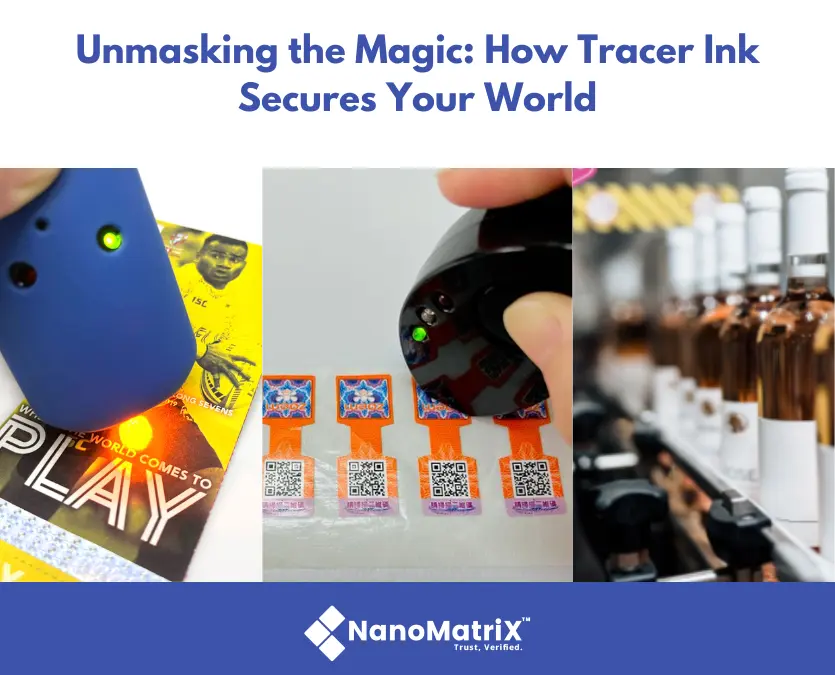Introduction
Picture a world where the authenticity of your purchases and documents is in perpetual doubt. A world where counterfeit products flood the market, contributing to an estimated 3.3% of global trade in 2019, and fraud runs rampant. A world where you can’t discern reality from deception. This bleak scenario could become a harsh reality if counterfeiting remains unchecked.
But what if there were a solution? A technology that silently guards the authenticity of products and documents across myriad industries. An invisible sentinel that unveils its secrets under specific conditions. A technological marvel and a bastion of security. This is where tracer ink comes into play.
In this comprehensive blog, we will unravel the intricate facets of tracer ink, a technology that stealthily safeguards our world. We will delve into its scientific composition, explore its diverse applications, underline its significance, scrutinise its environmental impact, and peer into its future prospects. Additionally, we will introduce MatriX-Mark™ Tracer Ink, an innovative solution that epitomises the prowess of tracer ink.
The Science Behind Tracer Ink
Tracer ink is formulated with unique properties that render it invisible under normal conditions but visible under specific circumstances. This feat is accomplished by employing unique pigments that absorb light at one wavelength and then re-emit it at another. This optical phenomenon, known as fluorescence, endows tracer ink with the unique ability to reveal itself under UV or infrared light.
In addition to fluorescence, tracer ink can also exhibit phosphorescence. Unlike fluorescence, where the emission of light stops almost immediately after the source of excitation is removed, phosphorescence entails a slow re-emission of absorbed energy over time. This quality allows the ink to continue glowing even after the UV or infrared light source has been extinguished.
Another pivotal element in tracer ink is the use of taggants. Taggants are minuscule particles incorporated into the ink during its formulation. These particles are engineered to react when exposed to a reader, verifier, or scanner using UV or infrared light of a specific wavelength. The resultant reaction can be read and deciphered by specialised equipment, adding an additional layer of security.
The formulation of tracer ink can be tailored to suit its intended application. For instance, inks meant for printing on paper may exhibit different properties than those intended for plastic or metal surfaces. Factors such as the substrate material, printing process, and desired security features all influence the specific formulation of the tracer ink.
Applications of Tracer Ink
- Consumer Goods: Counterfeiting poses a significant challenge to the consumer goods industry, causing financial losses and jeopardising consumer safety. Tracer ink is deployed to safeguard branded products by application to product packaging or labels, making counterfeiting an arduous task.
- Pharmaceutical Industry: The pharmaceutical sector benefits immensely from tracer ink. Counterfeit drugs can have fatal consequences. Tracer ink is employed on pharmaceutical packaging to ensure product integrity, thwart tampering, and facilitate easy product authenticity verification.
- Supply Chain Management: Tracer ink facilitates supply chain management by marking products or components, ensuring easy tracking and authentication. This safeguards products from being swapped with counterfeits throughout the supply chain.
- Government Documents: Government documents like passports, visas, and currency notes are prime targets for counterfeiters. Tracer ink, integrated into the printing process of these documents, thwarts fraud by revealing specific patterns or information under UV or infrared light, making counterfeiting exceedingly tricky.
- Banking and Finance: Tracer ink is employed on cheques and other financial documents for security purposes in the banking and finance sector. The ink can be tailored to react with specific chemicals, allowing for the detection of fraudulent activities such as check washing.
- Event Tickets: Event tickets are often counterfeited, especially for high-demand events like concerts and sports events. Tracer ink is used on these tickets to guarantee their authenticity.
Why Tracer Ink Matters
- Preventing Financial Losses: Counterfeiting leads to substantial financial losses for businesses. Tracer ink aids in averting these losses by ensuring product authenticity.
- Protecting Consumer Safety: Counterfeit products can threaten consumer safety severely, particularly in the pharmaceuticals and consumer goods sectors. Tracer ink shields consumers by preventing the circulation of counterfeit products.
- Aiding in Supply Chain Management: Tracer ink’s role in marking products and components ensures smooth tracking and authentication throughout the supply chain.
- Preventing Fraud: Tracer ink is pivotal in fraud prevention in sectors like banking and government. It can be used on cheques, currency notes, passports, and other documents to validate authenticity.
The Environmental Impact of Tracer Ink
Most traditional tracer inks are composed of synthetic materials, which can impose an environmental footprint during production and disposal. The manufacturing of these synthetic materials often necessitates energy-intensive processes and can generate waste that requires special handling due to their chemical composition. Nevertheless, the industry is diligently working towards mitigating this environmental impact through various means:
- Eco-Friendly Alternatives: Efforts are underway to develop eco-friendly alternatives, such as bio-based tracer inks derived from renewable resources rather than petroleum-based inputs. These alternatives reduce the environmental footprint of tracer ink production and enhance its cost-effectiveness.
- Efficient Production Processes: Technological advancements have led to more efficient processes that consume less energy and produce less waste. This dual benefit not only diminishes the environmental footprint of tracer ink production but also enhances its cost-effectiveness.
- Recycling and Disposal: The industry is actively improving recycling and disposal methods for products marked with tracer ink. This includes the development of inks that can be easily removed from products during the recycling process, as well as inks that are safe for disposal in regular waste streams.
- Regulations and Standards: Environmental regulations and standards play a pivotal role in shaping the environmental impact of tracer inks. Manufacturers are mandated to adhere to these regulations, which often encompass provisions for reducing emissions, managing waste, and ensuring worker safety.
The Future of Tracer Ink
- Bio-Based Tracer Inks: As the world prioritizes sustainability, the development of bio-based tracer inks has become more prevalent1. These inks are derived from renewable resources and offer an environmentally friendly alternative to traditional synthetic inks.
- Advanced Taggants: The use of taggants in tracer ink has become more sophisticated, with developments focusing on creating taggants that can react to a broader range of stimuli.
- Smart Packaging:The evolution of smart packaging has been a significant trend, with tracer ink playing a pivotal role. This involves merging digital technology with physical packaging to create interactive and secure packaging solutions.
- Internet of Things (IoT): With the rise of IoT, integrating tracer ink with connected devices has become more common. This bolsters tracking and authentication capabilities, enhancing security across various industries.
- Personalized Security Features: Businesses increasingly seek to differentiate their products and enhance brand loyalty. As a result, we see the development of personalised security features using tracer ink. This might entail creating unique tracer ink formulations for each brand or product line.
- Regulations and Standards: As the use of tracer ink becomes more widespread, additional regulations and standards have been developed to ensure its safe and practical application.
MatriX-Mark™ Tracer Ink: A Leap Forward in Tracer Ink Innovation
What sets MatriX-Mark™ apart is its remarkable formulation that seamlessly combines fluorescence and phosphorescence. This ingenious blend ensures that the ink remains imperceptible under standard lighting conditions but springs to life under the scrutiny of UV or infrared light. This dual-mode authentication makes MatriX-Mark™ Tracer Ink a powerful tool in the relentless fight against counterfeiting. Discover the remarkable attributes of MatriX-Mark™ Tracer Ink – a product that sets new standards in the realm of ink technology:
- Dual-Mode Authentication: MatriX-Mark™ excels in fluorescence and phosphorescence, creating a multi-layered security approach nearly impervious to counterfeiters.
- Formulations: This versatile tracer ink can be precisely tailored to suit specific applications, guaranteeing it meets the unique demands of various industries.
- Undetectable Tracers: MatriX-Mark™ Tracer Ink boasts completely invisible tracers, utterly impervious to detection without proprietary scanners.
- Signatures: These signatures are infinitely customizable, allowing for product personalization and precise supply chain tracking.
- Microscale Engineering: Engineered down to the micron scale, it seamlessly integrates into any ink matrix for universal compatibility.
- Enhanced Environmental Responsibility: MatriX-Mark™ stands at the forefront of environmental responsibility, offering bio-based formulations and efficient production processes, reducing the environmental footprint while enhancing cost-effectiveness.
- Future-Ready: With a keen eye on the future, MatriX-Mark™ is constantly evolving, and adapting to meet the ever-changing demands of security and authentication.
Curious to learn more? Click here for further insights and to arrange a meeting with our esteemed experts.
Conclusion
FAQs
1. What Is the Primary Purpose of Tracer Ink?
Tracer ink is primarily designed to enhance the security and authenticity of products and documents by remaining invisible under normal conditions but visible under specific circumstances, typically under UV or infrared light. It serves as a powerful deterrent against counterfeiting and fraud.
2. How Does Tracer Ink Contribute to Environmental Responsibility?How Does Tracer Ink Contribute to Environmental Responsibility?
Tracer ink manufacturers are increasingly focused on minimising the environmental impact of their products. They are developing eco-friendly alternatives, such as bio-based tracer inks derived from renewable resources, and improving production processes to reduce energy consumption and waste. Additionally, some tracer inks are designed for easy removal during recycling, reducing their ecological footprint.
3. Can Counterfeiters Replicate the Signatures in Tracer Ink?
Counterfeiters face significant challenges when attempting to replicate tracer ink signatures. Tracer ink formulations are unique and often stored in encrypted databases. Additionally, the microscopic engineering of these signatures makes them extremely difficult to reproduce without proprietary equipment and knowledge, deterring counterfeiters.
4. How Can Businesses Integrate MatriX-Mark™ Tracer Ink Into Their Operations?
Integrating MatriX-Mark™ Tracer Ink into existing operations is seamless. Businesses receive guidance and support to ensure a smooth integration into their manufacturing processes. No significant equipment or process changes are required, making it a practical choice for enhancing security and authenticity.




Recent Comments